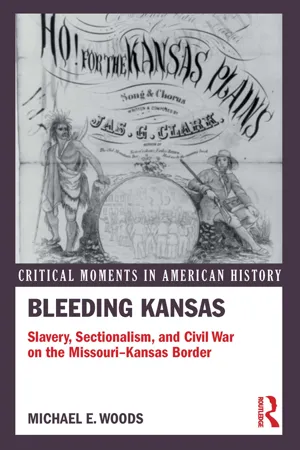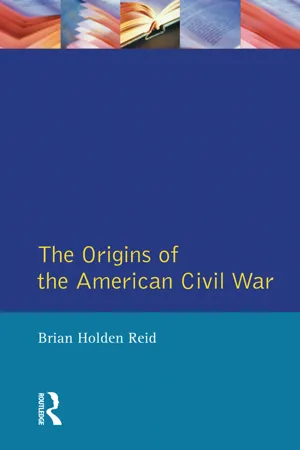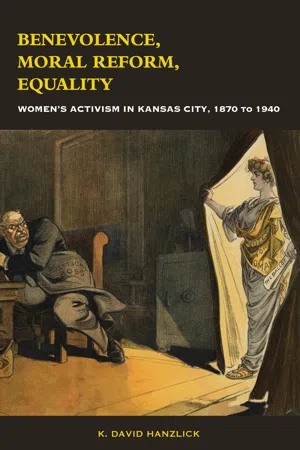Bleeding Kansas
"Bleeding Kansas" refers to the violent political and social conflicts that occurred in the Kansas Territory in the mid-1850s. These conflicts arose from the debate over whether Kansas would enter the Union as a free state or a slave state. The events in "Bleeding Kansas" foreshadowed the larger national conflict that would erupt into the American Civil War.
4 Key excerpts on "Bleeding Kansas"
- eBook - ePub
The American Civil War and Reconstruction
People, Politics, and Power
- Britannica Educational Publishing, Jeff Wallenfeldt(Authors)
- 2009(Publication Date)
- Britannica Educational Publishing(Publisher)
...Instead, a small civil war erupted between pro-slavery and anti-slavery advocates for control of the new territory of Kansas under the doctrine of popular sovereignty. Free-soil forces from the North formed armed emigrant associations to populate Kansas, while pro-slavery advocates poured over the border from Missouri. Regulating associations and guerrilla bands were formed by each side, and only the intervention of the Governor prevented violence in the Wakarusa War, launched in December 1855 over the murder of an antislavery settler. On May 21, 1856, “Bleeding Kansas” became a fact with the Sack of Lawrence, in which a proslavery mob swarmed into the town of Lawrence and wrecked and burned the hotel and newspaper office in an effort to wipe out this “hotbed of abolitionism.” The next day, the U.S. Capitol became the site of violence when Preston S. Brooks, a South Carolina congressman, brutally attacked Sen. Charles Sumner of Massachusetts at his desk in the Senate chamber because he had presumably insulted the Carolinian’s “honour” in a speech he had given in support of Kansas abolitionists. On May 24, back in Kansas, an antislavery band led by John Brown retaliated in the Pottawatomie Massacre. Periodic bloodshed along the border followed as the two factions fought battles, captured towns, and set prisoners free. A political struggle to determine the future state’s position on slavery ensued, centred on the Lecompton Constitution proposed in 1857. The question would not be settled until Kansas was admitted as a free state in January 1861, but, meanwhile, “Bleeding Kansas” had furnished the newly formed Republican Party with a much needed antislavery issue. The 1856 presidential election made it clear that voting was becoming polarized along sectional lines. Though James Buchanan, the Democratic nominee, was elected, John C. Frémont, the Republican candidate, received a majority of the votes in the free states. T HE D RED S COTT D ECISION The next year the U.S...
- eBook - ePub
Bleeding Kansas
Slavery, Sectionalism, and Civil War on the Missouri-Kansas Border
- Michael Woods(Author)
- 2016(Publication Date)
- Routledge(Publisher)
...CHAPTER 3 Bleeding Kansas and the Nation L ydia Maria Child was miserable. For an abolitionist and woman’s rights activist, the fall of 1856 was a discouraging time. Kansas had bled profusely but free-staters were no closer to victory over a federally-backed proslavery territorial government. The upcoming presidential election might help, but voting was reserved almost exclusively for white men. Would they support black freedom? Still worse was Child’s isolation in Massachusetts, far from Kansas and Washington alike. She used her pen to champion the free-state cause, and her money to assist free-state settlers, but she longed to do more. Late in October, Child vented her frustration in a private letter. “This is the death-grapple between Slavery and Freedom … and one or the other must go down!” she wrote. “Oh, what a misery it is, to feel in such a fever-heat of anxiety as I do, and yet be shut up … where I cannot act !” 1 Many Americans shared this anxiety over Kansas, despite the fact that most, like Child, never traveled there. But the controversy, and even the violence, from Bleeding Kansas came to them. Newspaper subscribers couldn’t avoid reading about it. Politicians couldn’t avoid discussing it. Anyone interested in the future of free labor, slave labor, and the American republic, had a deep interest in Kansas. Even those who tried to ignore politics had to cope with the bitterness that spread eastward across the entire country. And despite their distance from Kansas, thousands of northerners and southerners participated in the conflict. With their money, their voices, their votes, and sometimes their own weapons, pro- and antislavery Americans nationwide battled over Kansas just as fiercely as territorial settlers did. ⋆ ⋆ ⋆ Kansas settlers aggressively sought outside help. Public lecturers thrilled audiences with tales of bravery and betrayal on the plains...
- eBook - ePub
- Brian Holden Reid(Author)
- 2014(Publication Date)
- Routledge(Publisher)
...‘Self-defence’ in this case required driving Free Soil settlers from their farms and burning their towns. Both sides in this dispute believed that the other benefited from a secret military organization, which did not exist, but the pattern of the violence was hardly ‘military’. It was sporadic and on a tiny scale. The killing of one young man was sufficient to spark the ‘Wakarusa War’. Twelve hundred Missourians gathered to attack Lawrence, though they held off. In May 1856 Lawrence was indeed ‘sacked’ – one man was killed and a pro-slavery raider was killed when a brick fell off the roof of the Free State Hotel. The much denounced, brutal murder of five pro-slavery supporters committed by John Brown’s gang at Pottawatomie Creek was small beer, even by comparison with the twentieth century’s more notorious ‘serial killers’. 29 The violence in Kansas – which was a series of exaggerated descriptions of frontier brawls – contributed powerfully to a view after 1858 in both North and South that the war, if it came, would not be of significant intensity. We should not confuse the rhetoric employed to describe this militarily insignificant activity with the conclusions drawn as to its future importance. 30 Thus ‘drenching the Union in blood’, to cite a metaphor much favoured by southern spokesmen, actually meant ‘violence as described in Kansas’. It should not be construed as meaning that southerners expected any sustained or prolonged form of civil war. In the North, a view prevailed that should war be necessary, and the majority hoped that it would not, then it would resemble an affray like Shay’s Rebellion in Massachusetts in 1786. Then the militia dispersed effortlessly a body of discontented and truculent farmers who threatened to seize a federal arsenal at Springfield...
- eBook - ePub
Benevolence, Moral Reform, Equality
Women's Activism in Kansas City, 1870 to 1940
- K. David Hanzlick(Author)
- 2018(Publication Date)
- University of Missouri(Publisher)
...This struggle would mark the next decade. People from the East who supported the Free State cause poured into Kansas City on their way to settle in the newly opened Kansas Territory as the fight over the status of slavery in the territory eventually led to armed conflict. The American Hotel that served as lodgings for the easterners could barely accommodate the new arrivals. The hotel managers were forced to set up beds in the parlor when they filled the fifty or sixty private rooms. 10 The peaceful coexistence of people with varying identities, loyalties, and views proved tenuous. Just over a month after the Coateses’ landing in Kansas City, proslavery forces sacked Lawrence on May 21, 1856. A recent eastern transplant, John Brown, responded three days later with the so-called Pottawatomie Creek Massacre in which he and eight other men murdered five unarmed proslavery men. These incidents were a turning point in the violence on the border. 11 Sarah Coates observed how the conflict played out on the streets of Kansas City shortly after her arrival. She recounted that a Free State man from Kansas Territory was loading his wagon at the levee. He was “rudely accosted by a band of ruffians, who gave him orders to leave in less than an hour’s time or they would hang him ‘as high as Haman.’ . . . This treatment was in consequence of their suspicions that he was one of Brown’s party.” The second incident occurred not long after and involved seventy-five Free State men from Illinois who were disarmed at Lexington while on their way to Kansas. “A spy on board the boat landed some fifteen miles below Lexington, procured a horse, and rode him to death in order to give notice to Lexington’s pirates . . . some three or four hundred men being assembled there by the time the boat arrived.” Mrs. Coates related that the Free State men surrendered their arms. 12 Proslavery and Free State forces clashed violently along the border of Missouri and Kansas Territory...



